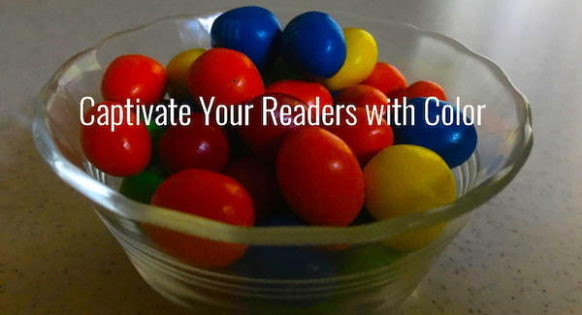 There are so many senses in which to immerse readers, and color plays a huge role in getting readers to feel like they’re right there in your story. In order to get the most out of each visual description, bust out that color palette and have some fun!
There are so many senses in which to immerse readers, and color plays a huge role in getting readers to feel like they’re right there in your story. In order to get the most out of each visual description, bust out that color palette and have some fun!
Go Beyond the Obvious
Sure, her dress was red, but would readers’ perception and attitude toward the character change if the dress was crimson or scarlet? Cherry red or garnet? Color can be aligned with the personality of the character or perhaps the scene in which it appears. A blush color might enhance a romantic scene, whereas blood red – well, you know where I’m headed with that one! If your character is strong and willful, perhaps mahogany or brick red is a better choice.
What Does it Mean?
Colors have meaning and symbolism. You’ll want to take that into account when choosing a color for your character to wear or set the scene in which they appear. Purple is associated with royalty. It is also a popular color for fantasy, mystery, and spirituality. Yellow? Joy, positivity, and curiosity. Green? Nature, harmony, and luck. Adding colors that reflect an emotion or direction of your story can give a subtle undertone of where you’re headed. The reader may not pick up on the association, but the feeling and tone will be there.
Symbolism?
Color is huge when it comes to marketing the products we purchase every day, and it’s equally important for your characters and the world in which they live. Do your research when choosing a particular color. Here are a few examples: Red represents good luck in China, but in South Africa it’s the color of mourning. Black is the color of mourning in Western countries, but in East Asian countries it’s white. In the U.S., green is the color of envy; in Germany, it’s yellow. Consider where your story is set and what is happening as you introduce color into the scene and clothe the bodies of your characters.
Adjust as Necessary
When the passion/danger is over, change out the red (energy, passion, danger) for a color that better suits what is happening now. If the scene fits, consider yellow (happiness, hope) or green (nature, harmony, stability). When you’re done writing for the day, it might be fun to watch your favorite TV program or movie and see if the creators use color to enhance its emotional or symbolic meaning. Did they get it right, or does the color seem to contradict what is happening or the emotions of the characters?
Color is a silent, but powerful tool in your writer’s toolbox. You don’t have to explain why you chose a particular color, but it will bring an added layer of meaning and emotion to every scene. I wonder if it holds true to that dish of M&Ms next to my computer. Hmm… I think I may need to do some serious color research on that one.
Photo by Anne Hawkinson

Shutta Crum
Always good. As a writer, a quilter, and someone who does mosaics…I’m addicted to color. So much fun. Thanks.
Eileen Hector
Blue, she always wore blue. It was the color of the sky where she wished to live. It was the melancholy color of her mood.
Therese Lombardo
Excellent post – love these reminders about the power of color!